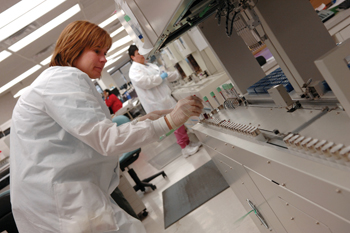
Lisa Lasseter loads blood samples into the inlet module at the start of the automated chemistry lab line. (photo by Dana Johnson)
Automation speeds chemistry lab’s work
A robotic production line rolled to life last March in the chemistry section of the Core Lab at Vanderbilt Diagnostic Laboratories.
The section performs around 3,000 assays per day — more than 1 million per year — on blood, urine and other fluid specimens collected from patients throughout Vanderbilt University Medical Center. The line's new conveyor belt, approximately 150 feet long, links up machines that prepare, analyze and store specimens.
The automation project is now drawing to a conclusion after a year of planning, followed by 10 months of intensive testing and implementation.
Martha Miers, administrator for Pathology and the laboratories, said turnaround time in the chemistry section has already measurably improved and increased productivity is beginning to be realized. Previously, about 50 percent of chemistry tests were completed in less than 60 minutes; with the automated line, 80 percent of tests are completed in less than 60 minutes. About 6 percent of the lab's volume comes from other hospitals.
“Instead of technologists working at each instrument, specimens are now automatically prepared, ushered through multiple instruments, stored, and later retrieved for retesting as needed, with minimum manual handling,” Miers said.
“In addition to aiding turnaround and productivity, this new level of automation lessens opportunities for errors in the lab,” she said.
The automation project involves a range of linked technology, including the lab information system, machines that prepare and divide specimens, a new suite of analytical instruments that perform the various assays, and fully automated storage units.
Fritz Parl, M.D., Ph.D., professor of Pathology and director of Clinical Chemistry, said much of the growing impetus for lab automation stems from a worsening national shortage of clinical laboratory technologists.
“At Vanderbilt, our testing volume has been rising 5 to 10 percent or more per year, and we simply don't have the technologists to cope with it,” Parl said.
In Vanderbilt's case, automation of the chemistry section meant changing equipment vendors and switching to a new suite of analytical instruments.
As new lab instruments are designed and marketed, changes occur in the precise methods of testing as well as in the targets of testing, and these advances sometimes involve altering the reference ranges that clinicians use to distinguish abnormal results from normal ones. Parl led testing of the new equipment.
As reference ranges changed for some tests, communication with clinicians became a major part of the project.
“Our goal is always to make sure any change is as seamless as possible to the clinician,” Parl said.
“They don't need to know the particulars of new testing methods, but it's important that they understand changes involving the meaning and interpretation of results.”
When asked whether there have been complaints from clinicians about the recent changes to reference ranges, Parl said, “They respect what we do even if they don't always agree. Considering the number of samples assayed, we're actually seeing relatively few complaints, and I think in our business it's fair to interpret that as a compliment to everyone working in the lab.”













